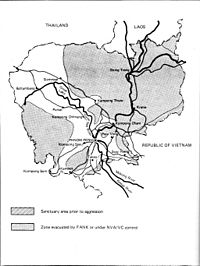- Operation Chenla II
-
Operation Chenla II Part of Cambodian Civil War, Vietnam War 
Map showing areas of Communist control.Date August 20 - December 3, 1971 Location Kompong Thom, Cambodia Result Decisive North Vietnamese victory Belligerents  North Vietnam
North Vietnam
 Viet Cong
Viet Cong Khmer Republic
Khmer RepublicCommanders and leaders Tran Van Tra Hou Hang Sin Strength 20,000+ 25,000+ Casualties and losses Unknown (Cambodian sources claimed 3,500+ killed during Phase I)1 Decimation of 10 FANK Battalions Operation Chenla II was a major military operation conducted by the Cambodian military (then known as FANK) during the Cambodian Civil War. It began on August 20 and lasted until December 3, 1971.
Contents
Summary
During the days of Prince Norodom Sihanouk's rule in Cambodia in the 1960s, the North Vietnamese and their NLF (Viet Cong) allies were able to use base areas in Cambodian territory in order to provide logistical support for their combat troops within the Republic of Vietnam (South Vietnam). In 1970, following the coup led by the pro-U.S General Lon Nol, the North Vietnamese aggressively expanded their control of northeastern Cambodia coming dangerously close to the capital Phnom Penh.
Initially, the small and poorly-equipped Cambodian Army was not up to the challenge, especially against the larger and more experienced NLF and North Vietnamese forces. However, by the summer of 1971, FANK had grown into a force of more than one-hundred thousand men with American and South Vietnamese assistance.
During the period between September 1970 and June 1971, FANK won its first victories after they successfully dislodged elements of the NLF's 9th Division along Route 13 and in some parts of the Mekong Delta.
Chenla II
By mid-1971 Lon Nol decided to renew the offensive against the Communist forces, taking advantage of the high morale among the Cambodian troops following their first victories. For the Cambodian armed forces everything was at stake as many reserves and prestige were invested in the operation. FANK's main goal was to reopen Route 6.
Initially the Cambodians achieved their objective as FANK units were able to retake Barai on August 26 and Kompong Thmar on September 1. But as FANK formations were advancing towards enemy territory along Route 6, they were heavily exposed without adequate protection from the flank. There was heavy fighting as the FANK 5th Brigade Group advanced towards Phnom Santuk while Tang Krasang was retaken on September 20. On October 5, three FANK brigades were committed to capture the areas around Phnom Santuk. The fighting there grew in intensity as the Cambodians and the NLF engaged in hand-to-hand combat. Phnom Santuk was eventually retaken, and the first phase of Chenla II was declared over on October 25 although real military success was not yet secured.
On the night of October 26, barely hours into the second phase of the operation, the North Vietnamese and NLF launched an assault on Cambodian positions along Route 6 from the Chamkar Andong rubber plantation. At the same time, the FANK 14th Battalion at Rumlong was encircled and isolated. During the following days, the 118th, 211th and 377th Battalions were forced to retreat to Tang Kauk, while the 61st Infantry Brigade pulled back to Treal, held by the 22nd Battalion.
The Cambodian army counter-attacked on October 27 but was unsuccessful and the Cambodian corridor along Route 6 was crushed by Communist troops during weeks of hard fighting. The elements of the NLF 9th Division than launched a final attack which ripped apart several battalions, causing Cambodian troops to abandon key positions on December 1. The operation was terminated two days later.
Result
For the Communist troops the battle ended with a decisive victory, North Vietnamese and NLF troops were able to secure their strongholds in northeastern Cambodia without having to expand their control inside Cambodian territory. As usual, another battlefield victory for the North Vietnamese meant another propaganda opportunity. On December 8, 1971, North Vietnamese propaganda boasted "By October, that is, in two months, the operation was stalemated and 4,500 enemy troops were annihilated and hundreds more captured. The 2nd and 43d Brigades were badly battered. Ten battalions and seven companies of infantry and a tank company were mauled , 39 combat vessels were sunk or set afire, nine aircraft were downed and seven 105mm artillery pieces, many vehicles and large quantities of military equipment were destroyed".2
Indeed, the final attack on Cambodian positions during the month of December virtually wiped out several battalions. Militarily and psychologically the damage suffered during Operation Chenla II was a big one from which the Cambodians would never recover.
References
- Bowman, John S. (1989). The Vietnam War Day by Day. New York: Mallard Books. ISBN 0-7924-5087-6.
- Sak Sutsakhan (1980). The Khmer Republic at War and the Final Collapse. Washington: U.S. Army Center of Military History. Available online at Part 1Part 2Part 3.
- Royal College Of Defence Studies 1975 Course - The War in Cambodia Its Causes And Military Development And The Political History Of The Khmer Republic 1970 - 1975.
External links
Categories:- 1971 in Cambodia
- 1971 in Vietnam
- Battles involving Vietnam
- Conflicts in 1971
- Battles and operations of the Vietnam War
- Battles and operations of the Cambodian Civil War
- Military history of Cambodia
Wikimedia Foundation. 2010.
